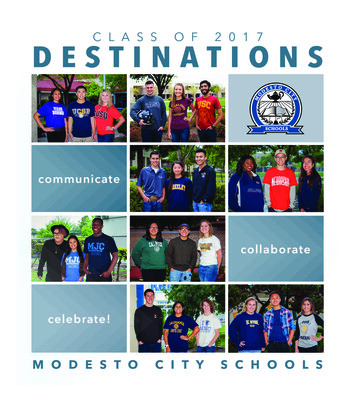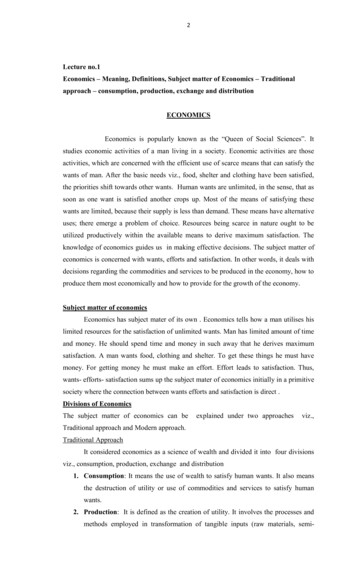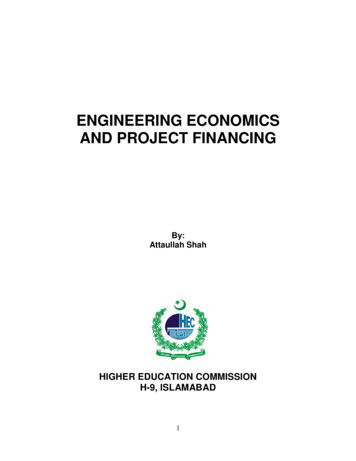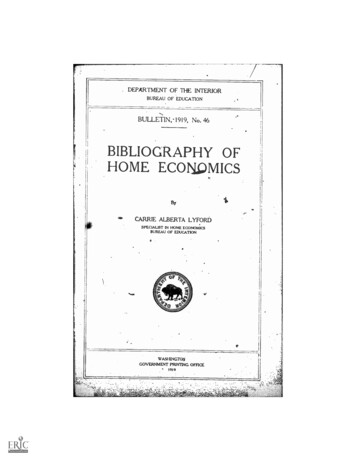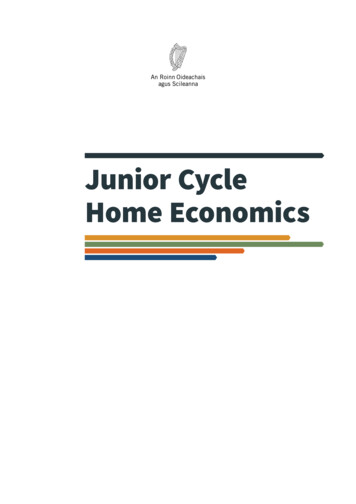
Transcription
Junior CycleHome Economics
ContentsPage3Introduction to junior cyclePage4RationalePage5AimPage6Overview: LinksStatements of LearningJunior Cycle Home Economics and Key SkillsPage10Overview: CourseContinuity and ProgressionPage18Expectations for StudentsLearning OutcomesPage22Assessment and ReportingPage29Appendix APage32Appendix B
3Junior CycleHome EconomicsIntroduction tojunior cycleIntroduction tojunior cycleJunior cycle education places students at the centre of the educational experience, enabling themto actively participate in their communities and in society and to be resourceful and confidentlearners in all aspects and stages of their lives. Junior cycle is inclusive of all students andcontributes to equality of opportunity, participation and outcome for all.The junior cycle allows students to make a greater connection with learning by focusing on thequality of learning that takes place and by offering experiences that are engaging and enjoyablefor them, and relevant to their lives. These experiences are of a high quality, contribute directlyto the physical, mental and social wellbeing of learners, and where possible, provide opportunitiesfor them to develop their abilities and talents in the areas of creativity, innovation and enterprise.The learner’s junior cycle programme builds on their learning to date and actively supports theirprogress in learning and in addition, supports them in developing the learning skills that willassist them in meeting the challenges of life beyond school.
4Junior CycleHome EconomicsRationaleRationaleThe central focus of home economics as a field of study is achieving optimal, healthy andsustainable living for individuals, families and society. Individuals and families in every societyare continually faced with new and emergent issues that can impact on their wellbeing. Suchissues include concerns relating to food, nutrition, diet and health; family and social concerns;consumer issues; sustainability in the home; responsible family resource management; and textilesand clothing.In home economics, students learn how to address these practical, real-world, perennial problemsof individuals, families, households and society in socially responsible ways. Practical perennialproblems or concerns are endured from generation to generation by families and require criticaldecision-making skills to resolve them. Home economics education uses a systems approach toempower individuals and families with the knowledge and skills to address these real-life concernsof everyday living. Home economics draws on diverse disciplines integrating social, physicaland human sciences. It strives to solve everyday challenges using a blend of knowledge andskills acquired from multiple disciplines. Home economics education develops students’ essentiallifeskills and personal independence. It supports the development of students who are critical,creative thinkers and encourages students to be problem-solvers capable of making ethically andsocially responsible decisions.
5Junior CycleHome EconomicsAimAimHome economics aims to develop students’ knowledge, attitudes, understanding, skills andvalues to achieve optimal, healthy and sustainable living for every person as an individual, andas a member of families and society. Students develop practical food and health literacy skills sothat they are enabled to adopt a healthy lifestyle and make informed decisions that positivelyimpact their health and wellbeing as individuals as well as within their families and society.Home economics nurtures students’ resourcefulness, innovation, adaptability, and competencyas consumers. It develops students’ creative design and textile skills. Home economics developsstudents who are environmentally conscious and dedicated to a sustainable and responsibleway of life.
6Junior CycleHome EconomicsOverview: LinksOverview: LinksHome economics supports a broad range of learning objectives at junior cycle. Tables 1 and 2on the following pages show how Junior Cycle Home Economics is linked to central features oflearning and teaching in junior cycle.Table 1: Links between Junior Cycle Home Economics and the statements of learningSTATEMENTS OF LEARNINGThe statementExamples of relevant learningSOL 13: The student understands theimportance of food and diet in makinghealthy lifestyle choices.Students will develop their food and healthliteracy skills so that they make positivelifestyle choices for themselves as individualsas well as within their families and society.SOL 10: The student has the awareness,knowledge, skills, values and motivationto live sustainably.Students will develop their critical thinkingand decision-making skills in order to live asustainable and responsible way of life.SOL 14: The student makes informed financialdecisions and develops good consumer skills.Students will develop their skills as discerningconsumers and demonstrate consumercompetency when managing financialresources in the home.SOL 9: The student understands the origins and Students will reflect on and analyse the impactsimpacts of social, economic, and environmental of products and processes in the home onaspects of the world around her/him.people, society and environments.SOL 11: The student takes action to safeguardand promote her/his wellbeing and that ofothers.Students will make informed decisions thatimpact his/her health, wellbeing and safety andthat of others.SOL 22: The student takes initiative, isinnovative and develops entrepreneurial skills.Students will develop their entrepreneurialskills as they seek to be innovative in dealingwith life’s challenges and opportunities.SOL 23: The student brings an idea fromconcept to realisation.Students will apply the design brief process intextiles and food to take an idea from concept torealisation.
7Junior CycleHome EconomicsOverview: LinksKey SkillsIn addition to their specific content and knowledge, the subjects and short courses of junior cycleprovide students with opportunities to develop a range of key skills. There are opportunities tosupport all key skills in this course but some are particularly significant. The examples belowidentify some of the elements that are related to learning activities in home economics. Teacherscan also build many of the other elements of particular key skills into their classroom planning.The eight key skills are set out in detail in Key Skills of Junior Cycle.The junior cycle curriculum focuses on eight key skills: Being creative Being literate Being numerate Communicating Managing information and thinking Managing myself Staying well Working with others.
8Key Skills of Junior CycleFigure 1: Key skills of junior cycle Developing my understanding andenjoyment of words and language Reading for enjoyment and withcritical understandingJunior CycleHome Economics Writing for different purposesOverview: Links Expressing ideas clearly andaccurately Knowing myself Making considered decisions Setting and achievingpersonal goals Developing my spoken language Being able to reflect on my own learning Exploring and creating a variety oftexts, including multi-modal texts Using digital technology to managemyself and my learning Using language Using numbers Listening and expressing myself Performing and presentingBEINGLITERATE Discussing and debating Using digital technologyto communicateCOMMUNICATINGMANAGINGMYSELF Being healthy andphysically active Being social Being safe Being spiritual Developing goodrelationships and dealingwith conflictWORKINGWITHOTHERS Co-operating Respecting differenceKEYSKILLS Being confident Being positive aboutlearningSTAYINGWELL Being responsible, safeand ethical in usingdigital technology Contributing to makingthe world a better place Learning with others Working with othersthrough digitaltechnologyBEINGCREATIVEMANAGINGINFORMATION& THINKINGBEINGNUMERATE Being curious Gathering, recording,organising and evaluatinginformation and data Thinking creatively and critically Reflecting on and evaluatingmy learning Imagining Exploring options and alternatives Implementing ideas and taking action Learning creatively Stimulating creativity using digitaltechnology Expressing ideas mathematically Using digital technologyto access, manage and sharecontent Estimating, predicting and calculating Developing a positive dispositiontowards investigating, reasoningand problem-solving Seeing patterns, trends and relationships Gathering, interpreting and representing data Using digital technology to developnumeracy skills and understandingwww.juniorcycle.ie12914 NCCA Jr Cycle Key Skills Poster v2.indd 110/06/2016 12:58
9Junior CycleHome EconomicsTable 2: Links between Junior Cycle Home Economics and key skillsKey skillKey skill elementStudent learning activityBeing creativeExploring options andalternativesStudents apply the design brief process in the makingof a textile item for the individual or the home.Implementing ideasand taking actionOverview: LinksBeing literateExpressing ideasclearly and accuratelyStudents demonstrate the importance of effectivecommunication by making a complaint about aconsumer issue by letter/email.Being numerateDeveloping a positive,disposition towardsinvestigating,reasoning andproblem-solvingStudents apply their numerical skills in thepreparation of a budget; adapting recipe ingredients;weighing and measuring out ingredients; roomplanning; and measuring fabrics.Estimating, predictingand calculatingCommunicatingDiscussing anddebatingStudents will discuss family relationships and the roleof communication in strengthening relationships.Using numbersStudents conduct a lunch time survey on theconsumption of sugar-sweetened beverages among asample of the student body. Students devise a postercampaign displaying the results and promoting ahealthy eating message.ManagingThinking creativelyinformation and and criticallythinkingUsing ICT and digitalmedia to access,manage and sharecontentStudents, using technology, will work collaborativelyto plan a healthy, balanced menu for one day.ManagingmyselfMaking considereddecisionsStudents will work through a case study onpurchasing a new piece of technology for personaluse utilising their financial literacy skills inidentifying their available resources and needs andwants.Staying wellBeing healthy andphysically activeStudents will work collaboratively to investigate thenutritional requirements of a particular stage of thelifecycle.Being confidentStudents will participate in peer evaluation of studentdishes in a positive and constructive manner.Being positive aboutlearningStudents constructively evaluate each other’s textileitems.Contributing tomaking the world abetter placeStudents will advise on a sustainable everydaypractice that can be applied in the home, e.g.preventing food waste.Working withothers
10Junior CycleHome EconomicsOverview: CourseOverview: CourseThe specification for Junior Cycle Home Economics focuses on developing students’ understandingand skills to achieve an optimal, healthy and sustainable life through three inter-connectedcontextual strands: Food, health and culinary skills; Responsible family living; and Textiles andcraft. Home economics uses an interdisciplinary approach which encourages the integration of thethree strands in the teaching and learning of the subject. It has been designed for a minimum of200 hours of timetabled student engagement across the three years of junior cycle.Figure 2: The strands of Junior Cycle Home ly livinge falbsiondFood healthanftraRespStrand 1: Food, health and culinary skillsThis strand focuses on developing students’ food, health and culinary skills. Students are enabledto develop a healthy, sustainable attitude and positive relationship with food through practicalexperiential learning. They apply their understanding of nutrition, diet and health principlesin order to adopt a healthy lifestyle and make informed decisions that impact the health andwellbeing of themselves as individuals as well as within their families. The application of practicalfood and health literacy skills is integral to this strand and includes menu planning; shopping;cooking; health and safety food skills; portion control; reading food labels; dietary analysis;costing; sensory analysis; and food waste.
11Junior CycleHome EconomicsOverview: CourseStrand 2: Responsible family livingThis strand enables students to explore, from a systems perspective, responsible family living.Students develop an understanding of the different forms and role of families as the core socialunit. They develop an understanding of the role of the family in the development of the childin a safe and nurturing environment. Students develop lifeskills to enable them to manageresources responsibly and sustainably in the home, family and community. They are facilitated tobecome discerning, competent consumers who are able to apply effective decision-making skillsin everyday contexts in the home and community. Enabling students to become responsible andhave a caring attitude towards other individuals, family members, society and the environment isintegral to this strand.Strand 3: Textiles and craftThis strand focuses on developing students’ textile skills, knowledge and creativity. Practicaltextile and craft skills are integral to this strand and include hand and machine sewing skills,and fabric texturing and embellishment techniques. Students are enabled to make sustainabledecisions as consumers in the choice and maintenance of clothing and textiles. Students will applythe design brief process in designing and making a textile item for an individual or the home.ElementsWhile the learning outcomes associated with each strand are set out separately here, this shouldnot be taken to imply that the strands are to be studied in isolation. The students’ engagement andlearning are optimised by a fully integrated experience of learning in home economics. To givefurther emphasis to the integrated nature of learning in home economics, the outcomes for each ofthe strands are grouped by reference to four elements (Figure 3): Individual and family empowerment Health and wellbeing Sustainable and responsible living Consumer competence.
12Junior CycleHome EconomicsOverview: CourseFigure 3 : The elements of the contextual strands showing the integrated nature of Junior Cycle HomeEconomicsSTRAND TWOResponsiblefamily livingSTRAND ONEFood, health andculinary skillsSTRAND THREETextiles and craftIndividual and family empowermentHealth and wellbeingSustainable and responsible livingConsumer competenceIndividual and family empowermentAcross the strands, the learning outcomes in this element focus on a systems approach toindividual and family empowerment. Students develop practical lifeskills that can be adapted toaddress practical, real world, perennial problems or concerns in everyday contexts in the home,family and society. They are facilitated to develop as critical, creative thinkers and problem-solversable to make informed decisions to achieve optimal, healthy and sustainable living for individuals,households, families and society.Health and wellbeingThis element focuses on developing students’ knowledge, skills and understanding to makeinformed decisions that positively impact on their health and wellbeing of themselves asindividuals as well as within their families. Across each of the three strands students arefacilitated, using a systems approach, to address new and emergent practical concerns that canimpact on the wellbeing of individuals, families and society.Sustainable and responsible livingAcross the strands, the learning outcomes in this element facilitate students to develop as futureoriented thinkers and environmentally-conscious citizens, committed to a sustainable andresponsible way of life. Developing students’ self-efficacy, critical reflection and discernment inthe choice and use of resources in the home; in technological change; in environmental issuesand the impact of these on resource management in the home and in personal consumption foreveryday living underpin the learning outcomes in this element across each of the three strands.
13Junior CycleHome EconomicsOverview: CourseConsumer competenceThis element focuses on developing students who have the knowledge, skills and understandingto make informed and discerning consumer choices that affect individuals, families andhouseholds in contemporary society. Students develop the essential lifeskills to become active,adaptable, consumer-literate citizens able to apply effective decision-making skills ineveryday contexts.Each element focuses on the goals of the learning process, that is, the acquisition of newknowledge, skills and values. As the student progresses through each of the learning strands,there will be a systematic development of their fundamental knowledge, principles and valuesand key skills.Progression from primary to senior cyclePRIMARY CURRICULUMWhile home economics is not a stand-alone subject within the Primary School Curriculum, inits strands, elements and outcomes, Junior Cycle Home Economics can progress related learningthat has taken place at primary level. The primary Social, Personal and Health Educationcurriculum aims to nurture the personal development, health and wellbeing of the child andencourages them to become active and responsible citizens in society. Within the curriculum areaof Social, Environmental and Scientific Education (SESE), students are facilitated to develop anunderstanding of the natural, human, social and cultural dimensions of the world around them.SESE aims to develop students who are informed and caring members of communities. Suchawareness, attitudes, knowledge and skills are addressed and developed in the study of homeeconomics in junior cycle.SENIOR CYCLEJunior Cycle Home Economics will provide strong links to Leaving Certificate Home Economicswith students building on their knowledge and practical skills in food studies, resourcemanagement, consumer studies and social studies from junior cycle. If students choose theLeaving Certificate optional pathway of textiles, fashion and design they will develop the practicaltextile skills established at junior cycle. Elements of home economics feature in many schoolsas part of a Transition Year (TY) programme. These elements and associated activities includepractical food skills and nutrition modules; food business; mini-company; social enterprises;childcare; design and craft; fashion design; interior design; and cookery and textile competitions.Furthermore, home economics at junior cycle prepares students who opt for the LeavingCertificate Applied (LCA) vocational specialisms of Hotel, Catering and Tourism, and Childcare/Community Care.
14Junior CycleHome EconomicsExpectationsfor StudentsExpectationsfor StudentsExpectations for students is an umbrella term that links learning outcomes with annotatedexamples of student work in the subject specification. When teachers, students or parents lookingat the online specification scroll over the learning outcomes, a link will sometimes be availableto examples of work associated with a specific learning outcome or with a group of learningoutcomes. The examples of student work will have been selected to illustrate expectations and willhave been annotated by teachers. The examples will include work that is: Exceptional Above expectations In line with expectations.The purpose of the examples of student work is to show the extent to which the learning outcomesare being realised in actual cases.Learning outcomesLearning outcomes are statements that describe what knowledge, understanding, skills andvalues students should be able to demonstrate having studied home economics in junior cycle.The learning outcomes set out in the following tables apply to all students. As set out here theyrepresent outcomes for students at the end of their three years of study. The specification stressesthat the learning outcomes are for three years and therefore the learning outcomes focused on ata point in time will not have been ‘completed’ but will continue to support the students’ learning inhome economics up to the end of junior cycle.The outcomes are numbered within each strand. The numbering is intended to support teacherplanning in the first instance and does not imply any hierarchy of importance across the outcomesthemselves. Junior Cycle Home Economics is offered at a common level. The examples of studentwork linked to learning outcomes will offer commentary and insights that support differentstandards of student work.
15Junior CycleHome EconomicsExpectationsfor StudentsStrand one: Food, health and culinary skillsThis strand focuses on developing students’ food, health and culinary skills. Students are enabledto develop a healthy, sustainable attitude and positive relationship with food through practicalexperiential learning. They apply their understanding of nutrition, diet and health principlesin order to adopt a healthy lifestyle and make informed decisions that impact the health andwellbeing of themselves as individuals as well as within their families. The application of practicalfood and health literacy skills is integral to this strand and includes menu planning; shopping;cooking; health and safety food skills; portion control; reading food labels; dietary analysis;costing; sensory analysis; and food waste.ELEMENT: Individual and family empowermentStudents should be able to:1.1identify the factors that affect personal food choices1.2plan, prepare, cost and evaluate healthy and nutritious individual and family mealsand snacks1.3apply a range of cooking principles and techniques in the preparation of healthy individualand family meals incorporating budgetary considerations1.4demonstrate culinary and creative skills in relation to the preparation, cooking andpresentation of food1.5apply safe and hygienic practices in food handling, preparation, storage and serving1.6using a problem-based learning approach, apply nutritional knowledge in the planning andpreparation of food for the family1.7use available technology for food planning and preparationELEMENT: Health and wellbeingStudents should be able to:1.8discuss the elements of a healthy lifestyle1.9recognise the importance of nutrition and diet in contributing to health and wellbeing1.10 explain the role of the nutrients in contributing to a healthy balanced diet1.11 describe the basic structure and basic functions of the digestive system1.12 investigate the nutritional requirements at each stage of the lifecycle1.13 plan and prepare meals for individuals with diet-related diseases1.14 apply the nutritional requirements of individuals with special dietary considerations whenplanning and preparing mealsELEMENT: Sustainable and responsible livingStudents should be able to:1.15 investigate the impact of their food choices from an ecological and ethical perspective1.16 apply sustainable practices to the selection and management of food and material resourcesELEMENT: Consumer competenceStudents should be able to:1.17 compare common foods used in food preparation and how they affect the nutrition andsensory quality of the product1.18 evaluate commercial and homemade food products1.19 interpret the information found on a variety of food products using front-of-pack andback-of-pack food labels
16Junior CycleHome EconomicsExpectationsfor StudentsStrand two: Responsible family livingThis strand facilitates students to explore, from a systems perspective, responsible family living.Students develop an understanding of the different forms and role of families as the core socialunit. They develop an understanding of the role of the family in the development of the child ina safe and nurturing home environment. Students develop lifeskills to enable them to manageresources responsibly and sustainably in the home, family and community. They are facilitated tobecome discerning, competent consumers who are able to apply effective decision-making skillsin everyday contexts in the home and community. Enabling students to become responsible andhave a caring attitude towards other individuals, family members, society and the environment isintegral to this strand.ELEMENT: Individual and family empowermentStudents should be able to:2.1discuss the different forms of the family2.2explore the roles and responsibilities of the family2.3discuss family relationships and the importance of strengthening relationships betweenindividuals and familiesELEMENT: Health and wellbeingStudents should be able to:2.4discuss the requirements of a safe and nurturing home environment2.5assess the importance of making informed and responsible decisions in everyday life2.6apply the design principles and guidelines to room planning and the design of an interiorspace in the homeELEMENT: Sustainable and responsible livingStudents should be able to:2.7identify how individuals, families and households can contribute to sustainable andresponsible living2.8describe sustainable everyday practices in the home to include energy efficiency, wastemanagement and water conservation2.9explore the influence of technology on the management of personal, family and householdresourcesELEMENT: Consumer competenceStudents should be able to:2.10 apply consumer decision-making skills in the management of personal, family andhousehold resources for everyday living2.11 debate consumers’ rights and responsibilities2.12 examine how consumers are protected in Ireland by legislation, statutory andnon-statutory agencies2.13 apply financial literacy skills in the preparation and evaluation of a budget forindependent living
17Junior CycleHome EconomicsExpectationsfor StudentsStrand three: Textiles and craftThis strand focuses on developing students’ textile skills, knowledge and creativity. Practicaltextile and craft skills are integral to this strand and include hand and machine sewing skills,and fabric texturing and embellishment techniques. Students are enabled to make sustainabledecisions as consumers in the choice and maintenance of clothing and textile. Students will applythe design brief process in designing and making a textile item for an individual or the home.For the purposes of the learning outcomes and assessment in this specification the term ‘textile item’encompasses all textile-based crafts for an individual and the home.ELEMENT: Individual and family empowermentStudents should be able to:3.1demonstrate basic hand and machine sewing techniques3.2apply the design brief process and principles to the making of a creative textile item for anindividual or the home3.3apply basic hand sewing and/or machine sewing techniques to the making of a textile itemfor an individual or the home in a safe and appropriate way3.4demonstrate fabric embellishment techniquesELEMENT: Health and wellbeingStudents should be able to:3.5appreciate the therapeutic and leisure role of participating in textile workELEMENT: Sustainable and responsible livingStudents should be able to:3.6demonstrate ways in which clothing and/or textile household items can be repaired,reused, re-purposed, recycled and upcycled3.7evaluate textile care procedures used in the home from an environmental perspective3.8discuss the influences of trends and choices on textile and clothing, including ethical andecological considerationsELEMENT: Consumer competenceStudents should be able to:3.9apply their knowledge of textile care symbols
18Junior CycleHome EconomicsAssessmentand ReportingAssessmentand ReportingAssessment in education involves gathering, interpreting and using information about theprocesses and outcomes of learning. It takes different forms and can be used in a variety ofways, such as to record and report achievement, to determine appropriate routes for learners totake through a differentiated curriculum, or to identify specific areas of difficulty or strengthfor a given learner. While different techniques may be employed for formative, diagnostic andsummative purposes, the focus of the assessment and reporting is on the improvement of studentlearning. To do this it must fully reflect the aim of the curriculum.The junior cycle places a strong emphasis on assessment as part of the learning process. Thisapproach requires a more varied approach to assessment in ensuring that the assessment methodor methods chosen are fit for purpose, timely and relevant to the students. Assessment in JuniorCycle Home Economics will optimise the opportunity for students to become reflective and activeparticipants in their learning and for teachers to support this. This rests upon the provision forlearners of opportunities to negotiate success criteria against which the quality of their work canbe judged by peer, self, and teacher assessment; and upon the quality of the focused feedback theyget in support of their learning.Providing focused feedback to students on their learning is a critical component of high-qualityassessment and a key factor in building students’ capacity to manage their own learning and theirmotivation to stick with a complex task or problem. Assessment is most effective when it movesbeyond marks and grades, and reporting focuses not just on how the student has done in the pastbut on the next steps for further learning. This approach will ensure that assessment takes placeas close as possible to the point of learning. Final assessment still has a role to play, but is only oneelement of a broader approach to assessment.Essentially, the purpose of assessment and reporting at this stage of education is to supportlearning. Parents/guardians should receive a comprehensive picture of student learning. Linkingclassroom assessment and other assessment with a new system of reporting that culminates in theawarding of the Junior Cycle Profil
Home Economics Overview: Links 6 Overview: Links Home economics supports a broad range of learning objectives at junior cycle. Tables 1 and 2 on the following pages show how Junior Cycle Home Economics is linked to central features of learning and teaching in junior cycle. Table 1: Links between Junior Cycle Home Economics and the statements of .


